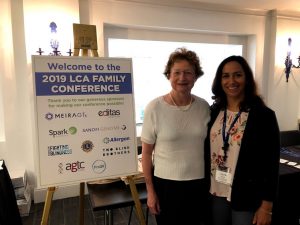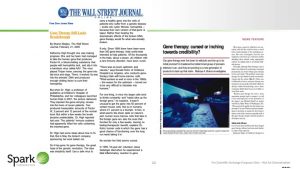Human Genome Project: Critical to Modern Gene Therapy Success
The long and sometimes uncompromising road to completing the Human Genome Project (HGP) paved the way for today’s surge in genetic therapy, Dr. Katherine A. High said in her presentation at the second Sofia See’s Hope LCA Family Conference.
“It was a tremendous achievement,” Dr. High said, “And it forms an important bedrock for everything we are trying to do in gene therapy.”
The HGP began in 1990 with an international, collaborative quest to map and understand all the genes of human beings and their roles in health and disease. The project, completed in 2003, revealed that there are probably about 20,500 human genes, referred to collectively as our genome, according to the National Human Genome Research Institute (NHGRI).

Dr. Katherine High and Sofia Sees Hope co-co-founder Laura Manfre at the LCA Family Conference in July.
Dr. High, keynote speaker and accomplished hematologist with a longstanding interest in gene therapy for genetic disease, kicked off the July 27 conference in Philadelphia.
More than 80 patients, family members, advocates, doctors, researchers and biotech industry leaders from 15 states and Mexico gathered for exchanges of knowledge and ideas about Leber congenital amaurosis, inherited retinal diseases (IRD) and other rare diseases. The conference grew out of the Sofia Sees Hope Family Connections program that brings together families living with LCA and other IRDs in a supportive community to help alleviate feelings of isolation that often come with a rare-disease diagnosis.
Dr. High and her team at Children’s Hospital of Philadelphia (CHOP), including Dr. Jean Bennett and Dr. Albert Maguire, developed – from clinical trials to regulatory approval – the first gene therapy for any inherited genetic disease in the United States; it also is the first genetic therapy targeting a retinal disease worldwide. The treatment focused on LCA caused by mutations in the gene RPE65, one of the more than 25 different genes, that, when mutated, can lead to LCA.
‘The Long & Winding Road’
Spark Therapeutics, a company that spun off the team’s research at CHOP, developed the therapy called LUXTURNA™ after 12 years of research and more than $500 million in investment. The U.S. Food and Drug Administration (FDA) approved the human-engineered, injectable drug in December 2017. Beginning in 2018, patients with low vision caused by LCA-RPE65 underwent surgery to help improve their eyesight.
LUXTURNA and the dozens of clinical trials now underway for retinal disease would not be possible if not for the HGP. Dr. High, Spark’s president and head of research and development, elaborated on the genome project in her presentation, “The Long and Winding Road: How the Human Genome Project and Gene Therapy Research Led to the First Gene Therapies for Genetic Disease.”
The ultimate product of the HGP – detailed information about the structure, organization and function of the complete set of human genes – can be thought of as the basic set of inheritable instructions for the development and function of a human being, according to NHGRI information.
Dr. High said the burden of genetic disease falls heavily on children’s hospitals, with 25 million Americans having a rare genetic disease.
A 4-year-old made genetic history after receiving the first genetic transfer in the United States in 1990, leading eventually to licensing of a product for the same disease in Europe in 2016. But that span of time did not represent an unbroken chain of successes, Dr. High said. “Instead, it was punctuated by a number of adverse events and failed results.”
Rocky road to success
A teenager died in a 1999 genetic trial in Philadelphia, and in 2003, children in a Parisian clinical trial developed leukemia.
“Gene therapy was just not ready for prime time and there was a decline in trials and participation.”
Headlines such as “Gene Therapy Still Lacks Breakthrough” and “Gene Therapy: cursed or inching toward credibility” mirrored waning interest from pharmaceutical companies and investors.
Instead, the American and European Societies of Gene and Cell Therapy, the National Institutes of Health (NIH), of which the National Human Genome Research Institute is part, and academic medical centers, like CHOP and its Center for Cellular & Molecular Therapeutics, sustained genetic therapy research through rough times, allowing investigators to develop therapeutics based on best science, not commercial considerations, Dr. High said.
Investing in the RPE65 blindness clinical trials during this time ultimately led to the development and FDA approval of LUXTURNA.
“The ability to work through those adverse events brought us to where we are now,” she said.
An ‘extraordinary’ level of activity
In the United States, the clinical development phase of a drug begins when a sponsor files an Investigational New Drug application (IND) with the FDA. IND submissions with gene therapy products went from zero in 1963, to three in 1990, to more than 100 in 2017. Following LUXTURNA’s market entrance in 2018, sponsors submitted more than 200 INDs.
“The level of activity in the last few years is truly extraordinary. It’s a very compelling statement of how people are investing time and energy into gene therapy,” which High said is probably the most complicated treatment researchers have tried to develop.
“It’s a complex therapeutic. The outside is a protein. The inside is a piece of DNA and those things have to be assembled in the exact proportions or it’s not going to work right.”
Dr. High also described the increased progression of identifying genes involved with vision – from zero in 1980 to more than 300 by January 2019.
“It’s daunting to think about the number of development programs that might need to be initiated and taken all the way through. But a journey of a thousand miles begins with a single step.”
